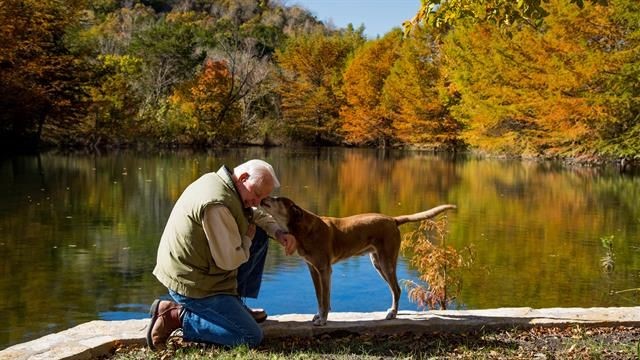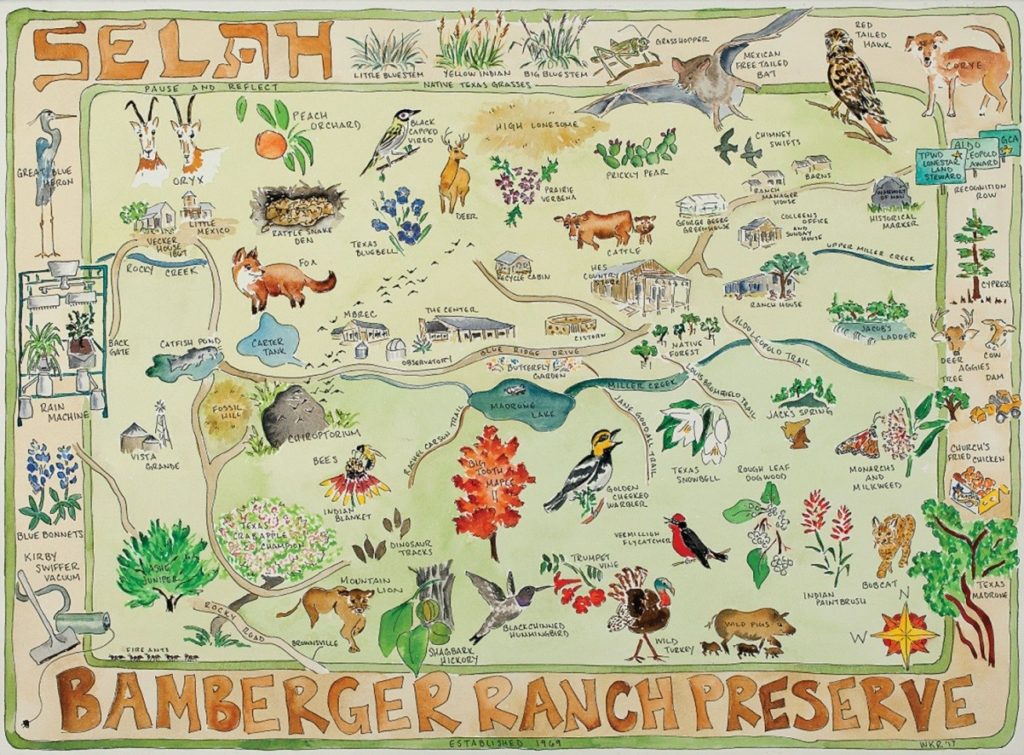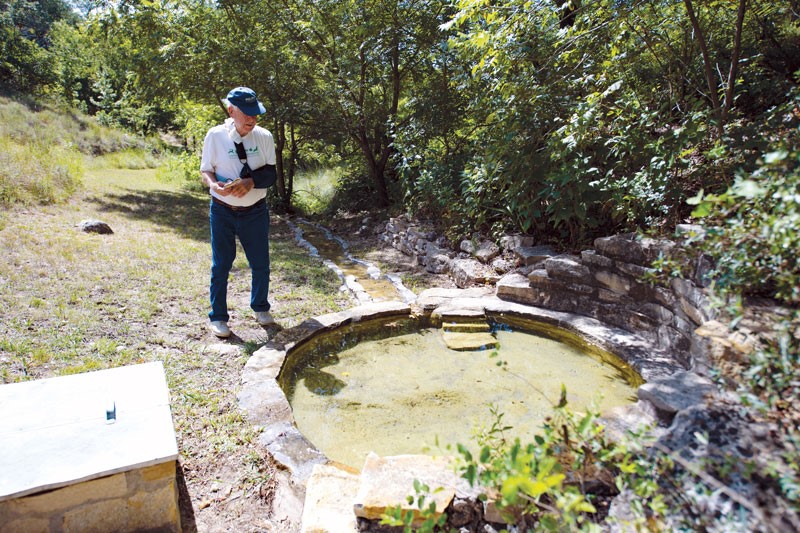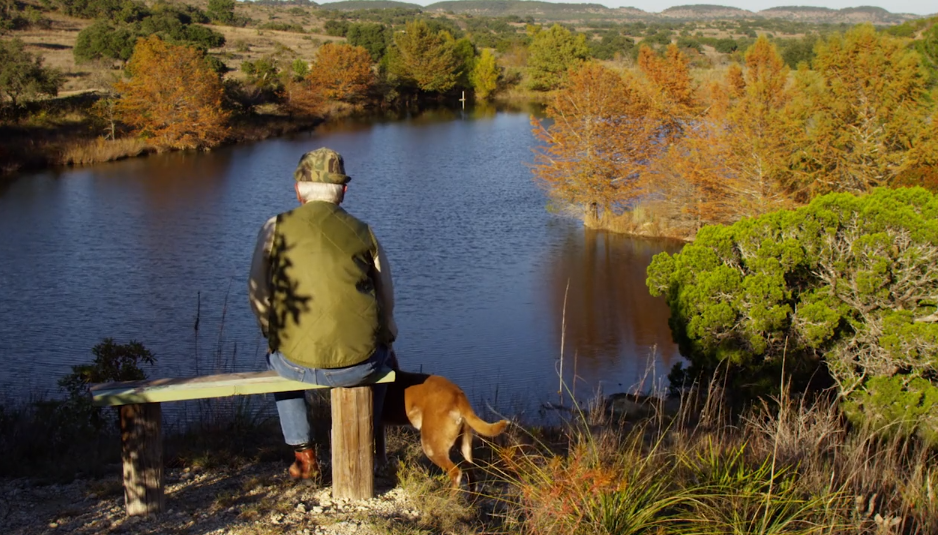Film: Visionary Transformed 5,500 Barren Acres With Grass
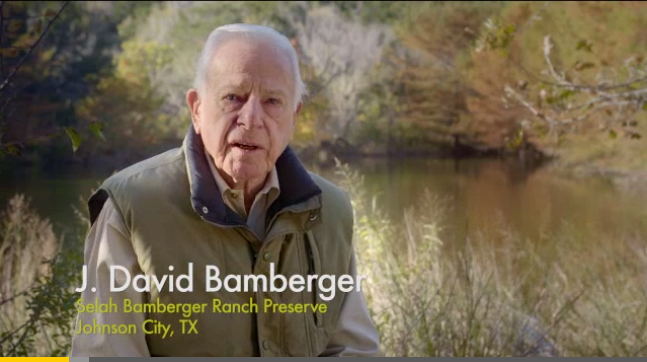 By Neenah Payne
By Neenah Payne
The film SELAH: Water From Stone, shows how J. David Bamberger restored 5,500 barren acres in Texas starting in the 1960s by planting native grass. Soon abundant water returned to the area along with fish, birds, deer, and other animals. In fact, his land produces enough water to channel some to the city of Austin via a tributary of the Pedernales River. Bamberger says “You need a chainsaw, wheelbarrow, axes, hand tools, and a lot of friends coming out from time to time, and a little time. You can buy used equipment and you can accomplish on your property what I’ve done here.” Bamberger’s example could not be more important because Texas is losing rural and agricultural land faster than any other state.
Selah: Water from Stone from Fin & Fur Films on Vimeo.
Three Books Document Bamberger’s Pioneering Tale
Seasons at Selah: The Legacy of Bamberger Ranch Preserve
Water from Stone: The Story of Selah, Bamberger Ranch Preserve
My Stories, All True: J. David Bamberger on Life as an Entrepreneur and Conservationist
Amazon says Bamberger has been profiled in The New York Times and The New Yorker, interviewed on NPR, and featured in a National Geographic video. He and his Texas Hill Country ranch have been the subject of many articles and two books published by Texas A&M University Press. In My Stories, All True, Bamberger, now in his nineties, tells the story of his life as an entrepreneur and conservationist in his own way. He made a living as a vacuum cleaner salesman, struck it rich as a partner in a wildly successful chain of fried chicken restaurants, and bought, then brought back to life, the “sorriest piece of land” in Blanco County, Texas — the rural oasis he calls “Selah, Bamberger Ranch Preserve”.
Bamberger shares the tales of a remarkable life — as a resourceful country boy, a savvy entrepreneur, and a consummate conservationist whose vision has set the standard for the restoration of nature on private lands worldwide. Growing up in rural Ohio during the Great Depression and World War II, Bamberger learned at an early age to shun waste, grow food productively, and admire the Amish for living in harmony with the land. His mother taught him to love the natural world and gave him a book that would set the course for his life: Pleasant Valley, by Louis Bromfield, a visionary American advocate for land restoration. Inspired by his new role model, Bamberger would say, “If I ever make money, I want to do what Bromfield did.”
After finding that financial success, Bamberger bought 5,500 acres that had been virtually destroyed by more than a century of misuse. Naming his preserve “Selah” —from the Old Testament term meaning “pause and reflect”— Bamberger dedicates himself and his resources to protecting species and educating school children, conservation groups, government officials, and everyone else who will listen to his central message: We must take care of the earth, and anyone can help.
David and his late wife, Margaret, have received many awards, and he has been featured in The New Yorker, in Audubon, and on CNN and network news. Today, Selah, Bamberger Ranch Preserve is one of the largest habitat restoration projects in the state and serves as a model for land conservation and environmental education. The ranch has earned numerous awards, including the coveted Leopold Conservation Award, the Texas Environmental Excellence Award in Education, the National Private Lands Fish and Wildlife Stewardship Award, and most recently, the Botanical Research Institute of Texas International Award of Excellence in Conservation, just to name a few.
Texas Rancher An Unlikely Environmentalist
“Bamberger has been hailed by the Texas Parks and Wildlife Department, and has won the state’s top voluntary land stewardship award. A visit to Bamberger Ranch is like a trip back in time. Instead of cedar brush and barren limestone breaking the soil’s surface, large hardwood trees surround grassy meadows. Wild turkey and deer wander in the open, and bobcats lurk in the hollows hunting game.
He started out in the 1940s in Ohio selling vacuum cleaners door to door. He eventually earned his college degree, but instead of moving into a respectable desk job, Bamberger stunned everyone by packing up his wife and baby, and moving to Texas, where he proceeded to sell ever more vacuum cleaners — 12 hours a day, six days a week. His parents and friends did not understand why this smart, likable young man didn’t move into a white-collar desk job with a little more dignity. “Everybody was disgusted with me,” Bamberger says. “Selling vacuum cleaners door to door — anybody could do that.” But Bamberger had discovered that he could make a small fortune door to door — and he did. It was straight commission. After 10 years, he had banked half a million…
He has spent 41 years strategically restoring his land. He cleared much of the juniper ash. He bought barrels of grass seed — throwing $5 handfuls of it into the wind from the back of his tractor. He planted hundreds of trees. It took decades of careful work by both Bamberger and nature, but now 3,000 people a year visit the ranch to see the results.”
Planting Native Grass Restored The Land
“Chad Norris, aquatic biologist for the Texas Parks and Wildlife Department, says the changes wrought by Bamberger are felt almost all the way to Austin. “What he does here affects the quality of the water running off the land, and in that respect, it affects everyone downstream.”
Mark Zuzanek is a software engineer who is attending his fourth workshop here. He’s already taken the Ranch tour, the Trees and Shrubs Workshop, the Native Grasses Workshop, and now he’s back for the Water Workshop. “I come here to learn, in a very short period of time, what it has taken these people 40-plus years to learn,” Zuzanek says.”
Natural and Non-Toxic Products. Up to 50% Off – Every Day (Ad)
Bamberger stresses that it was the introduction of the native grass shown below that was the primary factor in restoring the land. The roots of the grass help retain water in soil that flows into the aquifers which eventually produced 11 streams and a lake that has attracted a wide variety of wildlife.
Bamberger purchased 3,000 acres near Johnson City, north of San Antonio and southwest of Austin, which he later expanded by 2,500 acres. There was no grass and no live creeks, springs, or ponds. When Bamberger drilled a series of water wells, not one of them produced a drop. Undeterred, Bamberger assembled a group of Texas A&M-educated professionals…and went to work. With a used bulldozer, they attacked the cedar…. Then they planted native grasses to hold the topsoil in place.…Slowly, the landscape at Selah began to change. The hills took on a vibrant green hue. Instead of running off, the raindrops increasingly were absorbed into the soil, recharging a shallow aquifer just below the surface and, little by little, resurrecting the springs.
Today, there is water literally everywhere on the ranch, from the headwaters of Miller Creek, a tributary of the Pedernales River, to more than two dozen ponds and lakes fed by natural springs throughout Selah. Five families can live at the ranch on water supplied not from wells but from springs that didn’t even exist prior to Bamberger’s arrival. Today his example has never been more important. Texas is losing rural and agricultural land faster than any other state. One of the biggest environmental problems the state faces is the continued fragmentation of family lands. In this context, the Bamberger Ranch is a beacon of hope.
By the early 1990s, the Selah restoration project was showing results….Bamberger was serving on Gov. Ann Richards’ Task Force on Nature Tourism. The ranch regularly welcomes the public for nature tours and bat viewings. Visitors can also attend landowner seminars, and children come for hands-on classes and summer camps in one of the most beautiful settings in the heart of the Hill Country.
Margaret Bamberger Research and Education Center
It is increasingly children who are the ranch’s most important guests — a legacy of Margaret Bamberger, an artist and educator who married Bamberger in the 1990s. Margaret created the ranch’s educational programs and gave the ranch its credibility as an educational institution. Each year more than 3,000 kids from low-income schools and many more are brought to the ranch for outdoor fun and learning. The Margaret Bamberger Research and Education Center was created to honor his wife’s legacy.
David Bamberger on Fifty Years of Coaxing His Blanco County Ranch Back to Life
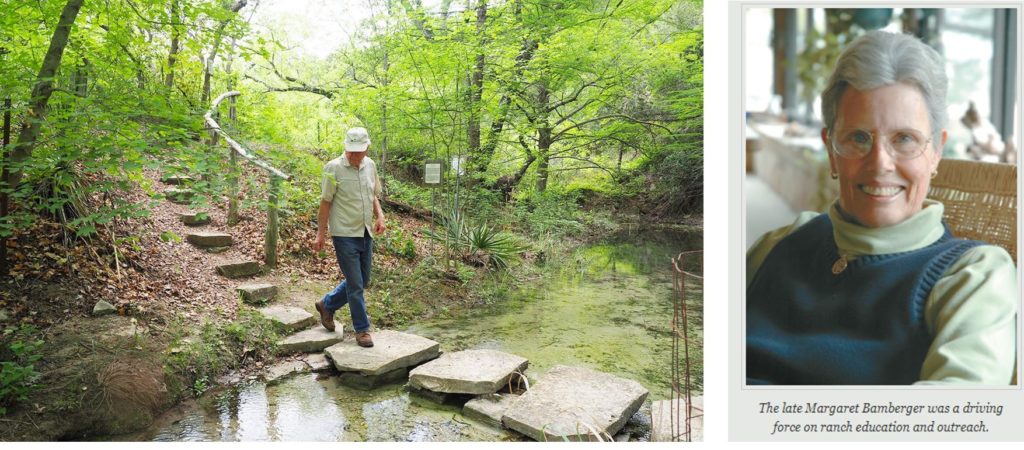 David Bamberger walks a trail at Selah, Bamberger Ranch Preserve.
David Bamberger walks a trail at Selah, Bamberger Ranch Preserve.
Fifty years ago, there wasn’t any water, there wasn’t any grass, there weren’t any seeds. We only found 48 species of birds. The latest bird count is 219 species. Now there are lakes you can swim in, creeks that run, and trees that weren’t here then.
Wringing water from rocks at Selah, Bamberger Ranch Preserve
“I preach the gospel of conservation,” Bamberger said. “I’m not a scientist. I’m not a biologist. I’m just a guy who loves nature so much I preach about it.” His team of experts and volunteers teaches workshops to landowners in hopes they will implement similar programs on their own properties. Visiting schoolchildren are awed by the simple yet dramatic demonstrations of how the system works. Through partnerships with universities, Bamberger has brought in professors and other experts to help with the recovery and record his progress.
“We are working to make this land look like it did 250 years ago,” Bamberger said. “Texas landowners didn’t do a good job of taking care of the land. When you overgraze, cease having fire, when you put too many goats, sheep, horses, cattle on the land, they not only eat everything, but their hoof actions compound the problem and cut out the grass.” Cedar begins to take over, shading the land so grasses die off. Rain evaporates off the top of cedar needles instead of soaking into the earth.
When Bamberger purchased the 5,500-acre ranch, he hired a man to drill for water. After seven dry wells, the driller told Bamberger he hit a hollow space in the ground that was at least 40 feet deep. He called it an underground cave. That’s when Bamberger began his quest for squeezing water out of rock. “We, with nature’s help, have taken it back to the natural state,” he said. “We have water now, and that water is here because of what you’re looking at: grass, grass, grass.”
Within 2½ years of replacing cedar with grass, water began to seep from the ground, eventually turning into springs. Bamberger and his team of volunteers, both amateur and expert, tracked the small steams to their origins, discovering most came from hilltops at the 125-foot level. Geologists call these hills “perched aquifers.” Perched aquifers are hills with a thin layer of top soil covering honeycombed limestone. Without grasses growing on the hills, rainwater washes off the top soil and evaporates before it can percolate into the earth. Bamberger adapted the next part of his plan straight from the Phoenicians 5,000 years ago.
He, his staff, and volunteers built horizontal stone berms along the hillside. The berms slowed the flow of rainwater, giving it time to seep into the ground and fill up the holes in the honeycombed rock. The berms also caught the top soil, keeping it from washing away. Over time, grass began to grow along the berms, further aiding percolation. “That cave underground, it filled up, and when it got full, it had to go somewhere,” Bamberger said.
It came out in springs that were guided by man-made paths through the rock into casements Bamberger and his team built near the bottom of the hill. From there, it fed into aqueducts and pipes and then into reservoir tanks and Madrone Lake. Yes, a tree-lined pristine lake complete with fish has formed on property once dry as a bone. “What’s coming out of here is the same water we drink,” Bamberger said. “We get thousands of gallons every 24 hours. While we’re sleeping, the water is still seeping.”
Not every piece of land in Texas has a perched aquifer. The Selah, Bamberger Ranch Preserve happens to have several that have so far created 11 springs, at least two of which continue to produce water even during a drought. The same principles used here, however, can be used to pull water from rocks on any property, Bamberger said. Again, it all goes back to grass. “It’s the greatest conservation tool ever created,” he said. Water from springs created by Bamberger’s conservation efforts are reserved in large tanks holding 47,000 gallons and in Madrone Lake. On what was once dry, parched land, 11 springs now produce thousands of gallons of water every 24 hours.
With the grass comes more water, and with grass and water come wildlife. A bird count on the property 50 years ago recorded 48 species on the ranch. The latest count is 219 species making their homes in the 6,000 trees Bamberger has planted over the years. Many of those trees now tower over the lake, grasses, and streams, adding color and essential habitat for foxes, rabbits, wild hogs, deer, and other wildlife.
Bamberger Ranch Preserve
The hogs and deer bring in hunters, who once shunned the place. The largest white-tailed deer harvested in the early 1970s weighed no more than 55 pounds. Last year, the smallest was 120 pounds and the largest 175. Hog hunters vie for weekend hunts through the late summer months, part of the population-control element essential to maintaining a balanced ecosystem at the ranch.
While this is an epic and miraculous tale with a beginning and a middle, it is a tale with no end, which is all part of Bamberger’s grand plan. He has been donating the land piece by piece over the years to a foundation that will continue after he is long gone. “I wanted to do something with this piece of land that makes a legitimate contribution to society as a whole,” Bamberger said. “The land will never be different. It will exist into perpetuity. That’s what I want to be my legacy.”
Seventeen years ago, Bamberger established the Bamberger Ranch Preserve to protect Selah long after his death, and he retired last July as chairman of the preserve’s board of directors. Once derided as a crackpot, he is now hailed as a visionary. “Given the chance, nature can heal itself,” Bamberger says. “Nature can heal us.”
Selah, Bamberger Ranch Preserve is located at 2341 Blue Ridge Drive in Johnson City. To find out about volunteer opportunities or make reservations for a tour or workshop, visit bambergerranch.org or call (830) 868-2630. You can become part of the never-ending story of how to squeeze water out of the rocks of Central Texas.
Also see Man Turns Degraded Land Into Massive Forest!
